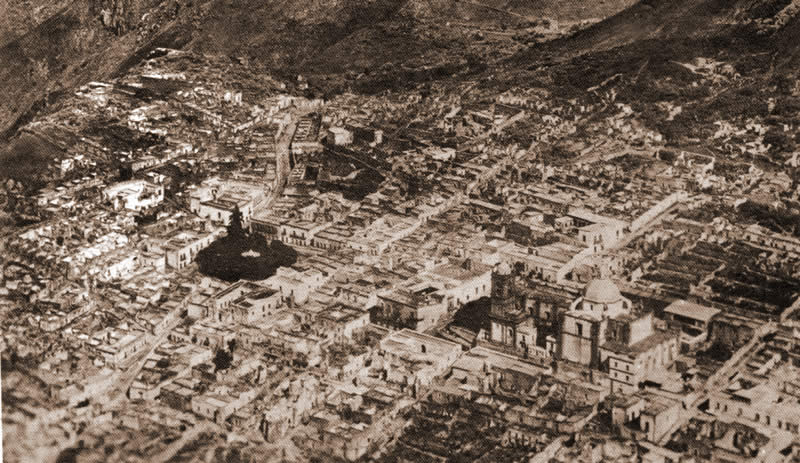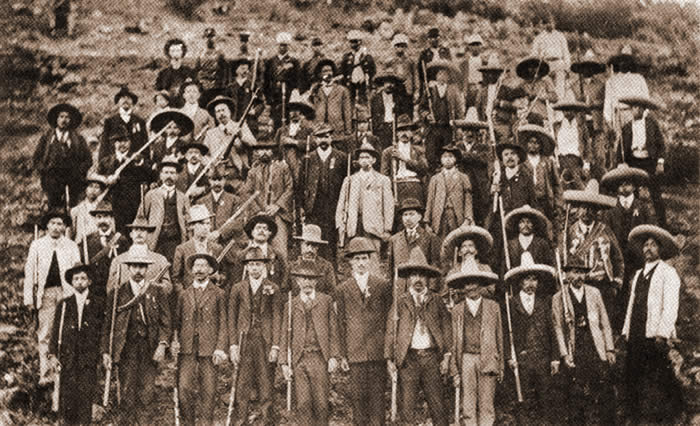The
Catorce district, supposedly, is named after an event in which 14
Spanish soldiers were killed by the indigenous
inhabitants. The mining history of the area goes back to the mid-eighteenth century and, as
the story goes, in 1772 a musician who was lost in the sierras, camped for a night and lit a
fire to keep warm. In the morning when he went to clean-up the remains of his campfire he was
surprised to find some little streams of silver metal fused on the
ground as the result of his fire which
were from outcrops of the mineralized vein since named the San Augustín. However, the
first significant discovery of silver mineralization was reported in 1773 when a couple of prospectors,
Sebastián Coronado and Antonio Llamas, discovered in the “Catorce Viejo” hill an argentiferous
vein that they started to exploit on a very low scale and named the mine “La Descudridora”
In 1778, Don
Bernabé Antonio de Zepeda, a miner from Matehuala began to
explore the Sierra de Catorce and discovered the
outcrops of the rich Veta Grande, in which he sank the Guadalupe shaft that produced a great amount of
red minerals along with abundant green and white silver. The major Veta Madre vein was also
discovered and exploited by Ventura Ruiz in 1778. In 1780, Padre José
Manual Flores and his brother acquired the Padre Flores of Zavala mine
for $700 and re-named it the “La
Bolsa de Dios” (The Purse of God). Small scale mining on the property soon lead to the
discovery of two “Bovedas” or vaulted chambers of soft chloride ore between 165 feet and 328 feet
below surface and within 3 years $7,000,000 worth of silver was extracted from the mine
(Southworth, 1905).
Other mines in the
district were the La Valenciana, La Concepción, El
Socavón del Refugio, and Candelaria y Filos.
By 1804, Catorce was the
third richest silver producing district in Mexico with an average yearly production worth between
$600,000 and $700,000. In its best producing years between $3,804,000 and $5,500,000 worth of silver
was extracted (Southworth, 1905).
The peasant uprisings of
1810 to 1821 were disastrous to the mining industry with both the insurgents’ soldiers and
royalist troops all but destroying the silver production in Mexico and
Real de Catorce was not spared
during this period.
Due to the richness of
the district, in 1817, Don Joaquín Enguía recommended
opening a mint house in Real de Catorce.
The Catorce mining
district after suffering the ups and downs during the early 1800s was
set on course by the Maza family,
starting in 1861 with the arrival of Don Gregorio de la Maza who built a mint (Casa de Moneda) during
the Don Benito Juarez presidency. The mint was briefly active from January, 1865 to February, 1866
when it was shut down by order of the Emperor Maximiliano, who was afraid it would fall into
the hands of Juarez’s forces.
The Maza family founded
the Compañía Minera de Santa Ana (Santa Ana mine) and, in
1885, mining management was taken
over by Don Vicente Irizar, who, with the help of an English mining engineer, David Coughlan, and
Coughlan’s son Francisco, assisted by Mexican mining engineer Don Luís Lopez,
developed the Santa Ana mine into a major mine which prospered during
the last quarter of the nineteenth
century. In 1896 the Santa Ana mine installed specially designed pumps
to remove water from the mine,
which were the first in the country to be powered by electricity. This event was inaugurated by
General Porfirio Diaz, President of Mexico.
Because of the
previously arduous journey to get into and out of the town of Real de
Catorce, the Ogarrio Tunnel was opened in
1901. Originally the mining passage had been cut through the solid rock to admit rail cars
carrying ore. Roberto Irizar planned the project and at a cost of one
million pesos the tunnel was enlarged
to accommodate a trolley line that would connect Real de Catorce with
Potrero.
After 1905, mining operations declined and due íto the political
and social instability generated during the 1910 Revolution mining was paralyzed almost completely,
except for small workings. By 1920, Real de Catorce was nearly a ghost town and the trolley and
train were removed Although ASARCO, in 1926, and Fresnillo, in 1937, evaluated the major
vein structures, a resurgence of mining activity did not take place until 1942 when a
small cyanide plant was constructed and operated for about ten years.
Subsequently little mining took place until 1965 when the
Compañía Restauradora de las Minas de Catorce, S.A. de
C.V. (Restauradora) was formed. A plant with a milling capacity of 150
tonnes/day was completed in 1967 and later expanded to 300 tonnes/day
(flotation). The process plant was subsequently expanded to treat old
tailings material, with a capacity at 500 tonnes/day of which 300
tonnes were processed from the flotation plant and 200 tonnes were
processed from the tailings dam. The final product was silver
doré bars with a 98.0% silver content with copper being the main
impurity with a 0.9% content. The plant operated until 1990 when it
shut down “because of low silver prices and high taxes”.
Subsequent to 1990, Restauradora conducted a program of surface
geochemical studies, geological, mapping and fluid inclusion studies in an attempt to identify new
mineralized zones.
Since 1998 the mine has remained inactive with Restauradora maintaining
the property.



